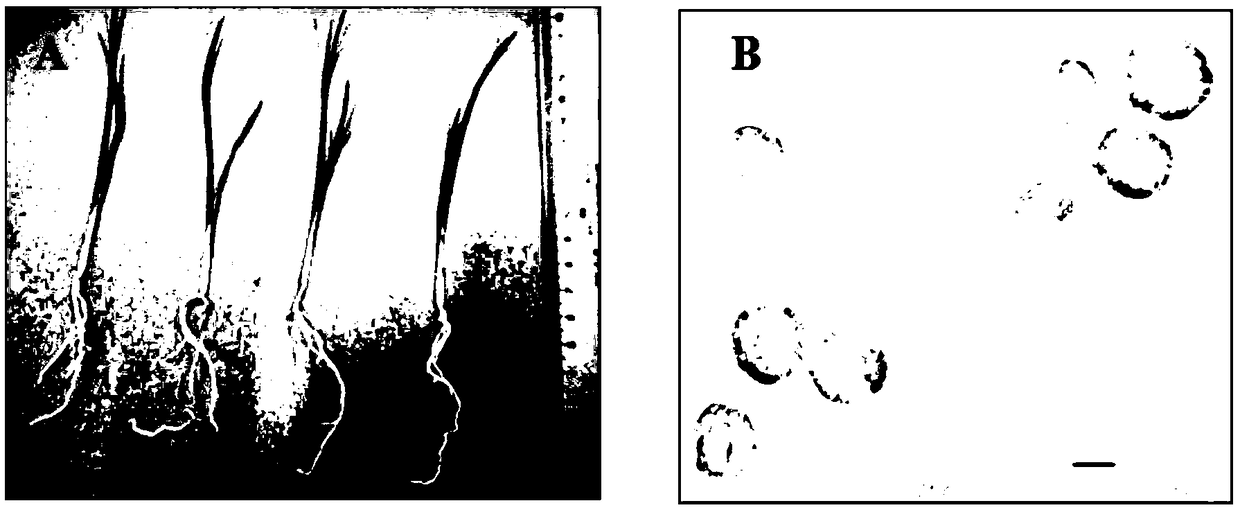Iris ensata thunb mesophyll protoplast and preparation method thereof
A technology of protoplast and horsetail, which is applied in the field of cell biology and biology, to achieve high-efficiency dissociation and overcome technical bottlenecks
- Summary
- Abstract
- Description
- Claims
- Application Information
AI Technical Summary
Problems solved by technology
Method used
Image
Examples
Embodiment 1
[0035] (1) Select young leaves of Sperus japonica with a healthy seedling age of 30, 45, and 60 days as treatment materials, wash them with tap water, put them into an ultra-clean workbench, sterilize with 70vt% absolute ethanol for 1min, sterilize with 5wt% sodium hypochlorite for 10-15min, and aseptically Rinse with water and set aside;
[0036] (2) Put the material obtained in step (1) on the sterile and dry filter paper in the ultra-clean workbench, and use sterile scissors or a scalpel to cut the leaves into 1-2 mm wide thin slices along the direction of the leaf veins. leaf shreds;
[0037] (3) In the ultra-clean workbench, put the cut fine leaf shreds into the beaker containing the sterile plasmolysis liquid at a ratio of 1g:30ml, and then wrap the beaker with sterile aluminum foil to avoid light for plasmolysis. Separation treatment 2h;
[0038] (4) Take the above-mentioned thin leaf silks that have undergone plasmolysis treatment, put them into pre-prepared beakers ...
Embodiment 2
[0043] (1) Select young leaves of Sperus japonica with a healthy seedling age of 30, 45, and 60 days as treatment materials, wash them with tap water, put them into an ultra-clean workbench, sterilize with 70vt% absolute ethanol for 1min, sterilize with 5wt% sodium hypochlorite for 10-15min, and aseptically Rinse with water and set aside;
[0044] (2) Put the material obtained in step (1) on the sterile and dry filter paper in the ultra-clean workbench, and use sterile scissors or a scalpel to cut the leaves into 1-2 mm wide thin slices along the direction of the leaf veins. leaf shreds;
[0045] (3) In the ultra-clean workbench, put the cut fine leaf shreds into the beaker containing the sterile plasmolysis liquid at a ratio of 1g:30ml, and then wrap the beaker with sterile aluminum foil to avoid light for plasmolysis. Separation treatment 2h;
[0046] (4) Take the above-mentioned fine leaf silks that have undergone plasmolysis treatment, put them into pre-prepared beakers ...
Embodiment 3
[0051] (1) Select young leaves of Sperus japonica with a healthy seedling age of 30, 45, and 60 days as treatment materials, wash them with tap water, put them into an ultra-clean workbench, sterilize with 70vt% absolute ethanol for 1min, sterilize with 5wt% sodium hypochlorite for 10-15min, and aseptically Rinse with water and set aside;
[0052] (2) Put the material obtained in step (1) on the sterile and dry filter paper in the ultra-clean workbench, and use sterile scissors or a scalpel to cut the leaves into 1-2 mm wide thin slices along the direction of the leaf veins. leaf shreds;
[0053] (3) In the ultra-clean workbench, put the cut fine leaf shreds into the beaker containing the sterile plasmolysis liquid at a ratio of 1g:30ml, and then wrap the beaker with sterile aluminum foil to avoid light for plasmolysis. Separation treatment for 3h;
[0054] (4) Take the above-mentioned thin leaf silks that have undergone plasmolysis treatment, put them into pre-prepared beak...
PUM
| Property | Measurement | Unit |
|---|---|---|
| width | aaaaa | aaaaa |
Abstract
Description
Claims
Application Information
 Login to View More
Login to View More - R&D
- Intellectual Property
- Life Sciences
- Materials
- Tech Scout
- Unparalleled Data Quality
- Higher Quality Content
- 60% Fewer Hallucinations
Browse by: Latest US Patents, China's latest patents, Technical Efficacy Thesaurus, Application Domain, Technology Topic, Popular Technical Reports.
© 2025 PatSnap. All rights reserved.Legal|Privacy policy|Modern Slavery Act Transparency Statement|Sitemap|About US| Contact US: help@patsnap.com

